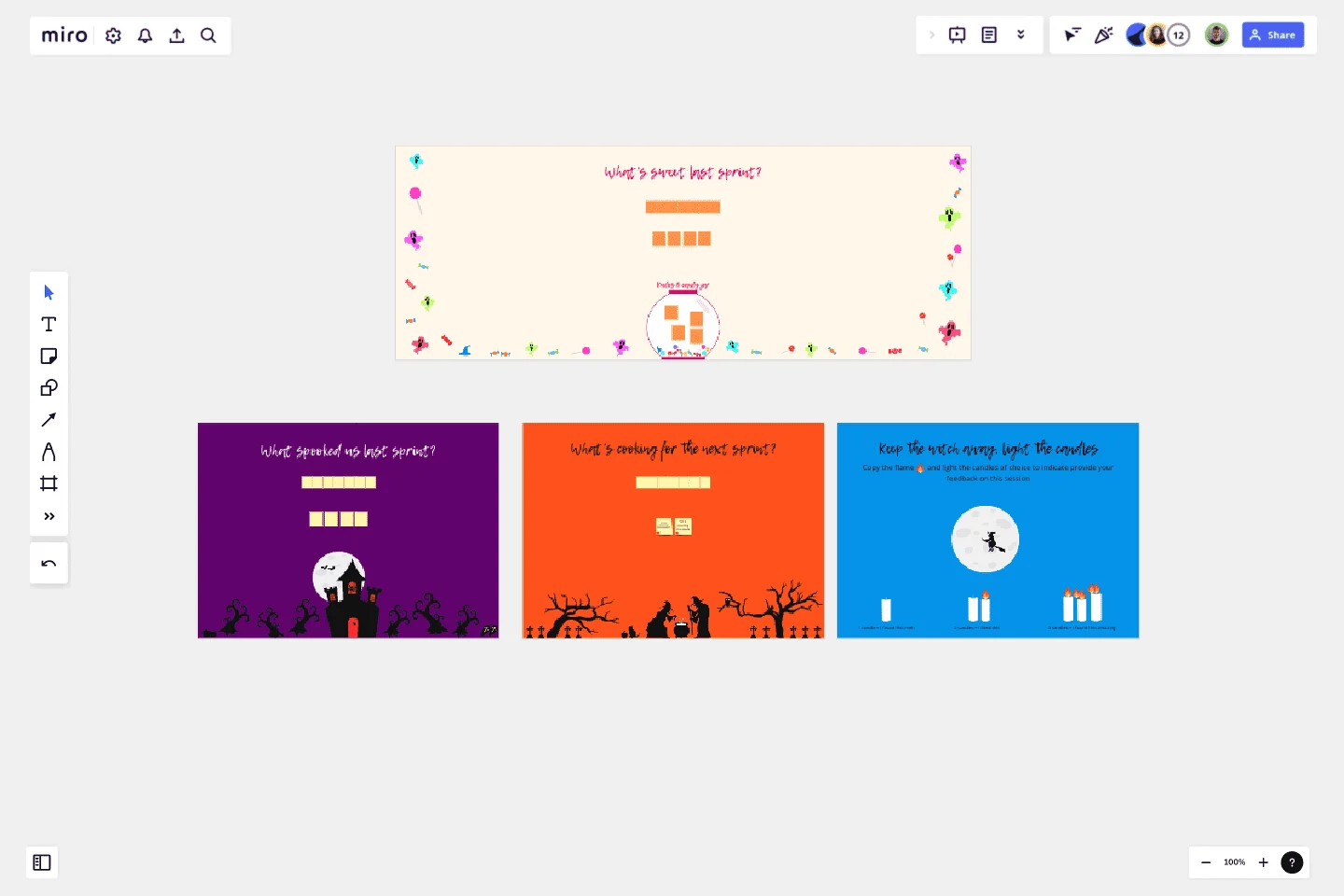A Halloween Retro
Make next steps less spooky and more actionable.
A Halloween Retro
October is Halloween month and if you're hosting a retrospective during this time, how can you even resist a Halloween-themed retro board? Bring out your spooky game, a cup of pumpkin spice latte and gear up to have the best retro of your life!
Halloween Bingo 🎃
For the icebreaker, we have a Halloween-themed bingo! The rules are the same as regular bingo - if you match with a square, mark it with the provided marker. If you complete a row across, down or diagonally, shout B-I-N-G-O! Once everyone has had a chance at marking their bingo sheets, browse around and discover some interesting tales.
What's sweet last sprint? 🍭
Halloween and no candies? Impossible! Drop some kudos in the candy jar to let them know how much their contributions mean to you. Next, make notes on what went well in the past sprint and discuss these points with your team.
What spooked us last sprint? 👻
Okay, this is scary but it has to be done. As a team, make notes of what didn't go well in the last sprint and discuss these points with your team. Don't spend too long here though or else the zombie will step out of his haunted house and make you his next meal.
What's cooking for the next sprint? 🍯
The wizard and the witch may be cooking a magic potion for their next trip, but in the meantime, you can jot down some action points for your next sprint. Based on what didn't go so well, come up with these possible actions to take as a team. Limit the total actions to either two or three, though, because having too many actions may not always be a good thing.
Keep the witch away, light the candles 🧙♀️
A wandering witch on a full moon is never a good idea. Keep her away by quickly lighting some candles. Based on how your team thought the retrospective went, ask them to copy the flame and light the desired group of candles to convey their feedback. Remember, you can have multiple flames for a candle because they're magic candles!
That's it. Happy retrospective!
This template was created by Clyde D'Souza.
Get started with this template right now.
Product Canvas Template
Works best for:
Desk Research, UX Design
Product canvases are a concise yet content-rich tool that conveys what your product is and how it is strategically positioned. Combining Agile and UX, a project canvas complements user stories with personas, storyboards, scenarios, design sketches, and other UX artefacts. Product canvases are useful because they help product managers define a prototype. Creating a product canvas is an important first step in deciding who potential users may be, the problem to be solved, basic product functionality, advanced functionalities worth exploring, competitive advantage, and customers’ potential gain from the product.
Design Research Template
Works best for:
UX Design, Design Thinking, Desk Research
A design research map is a grid framework showing the relationship between two key intersections in research methodologies: mindset and approach. Design research maps encourage your team or clients to develop new business strategies using generative design thinking. Originally designed by academic Liz Sanders, the framework is meant to resolve confusion or overlap between research and design methods. Whether your team is in problem-solving or problem space definition mode, using a research design template can help you consider the collective value of many unrelated practices.
Outcome Mapping Template
Works best for:
Diagrams, Mapping, Project Management
Use Miro’s outcome mapping template to improve your operational efficiency. Outcome mapping will help you visualize all the possible strategic outcomes for your upcoming project, allowing you to see into the black box to identify any potential challenges along the way.
Sprint Planning Template
Works best for:
Agile, Sprint Planning
The Sprint Planning Template is a useful tool for agile teams to organize and conduct sprint planning sessions. It enhances team collaboration and communication by providing a clear visual layout of sprint goals, tasks, and timelines. The interactive design ensures team alignment toward sprint objectives, leading to effective teamwork. The template is a central hub for planning, discussion, and decision-making, creating a collaborative and productive environment.
4Ps Retrospective
The 4Ps Retrospective template offers a structured framework for teams to reflect on past iterations or projects using the 4Ps model (Praise, Problems, Possibilities, and Plans). It provides elements for sharing positive feedback, identifying challenges, exploring opportunities, and setting action plans. This template enables teams to conduct retrospectives systematically, generate actionable insights, and drive continuous improvement. By promoting a balanced and comprehensive approach, the 4Ps Retrospective empowers teams to enhance collaboration, boost morale, and achieve their objectives effectively.
Brainwriting Template
Works best for:
Education, Ideation, Brainstorming
Brainstorming is such a big part of ideation. But not everyone does their best work out loud and on the spot, yelling out thoughts and building on others’ ideas. Brainwriting is a brilliant solution for them—creative thinkers who happen to be more introverted. This approach and template invites participants to reflect quietly and write out their ideas, and then pass them to someone else who will read the idea and add to it. So you’ll get creative ideas from everyone—not just the loudest few.
